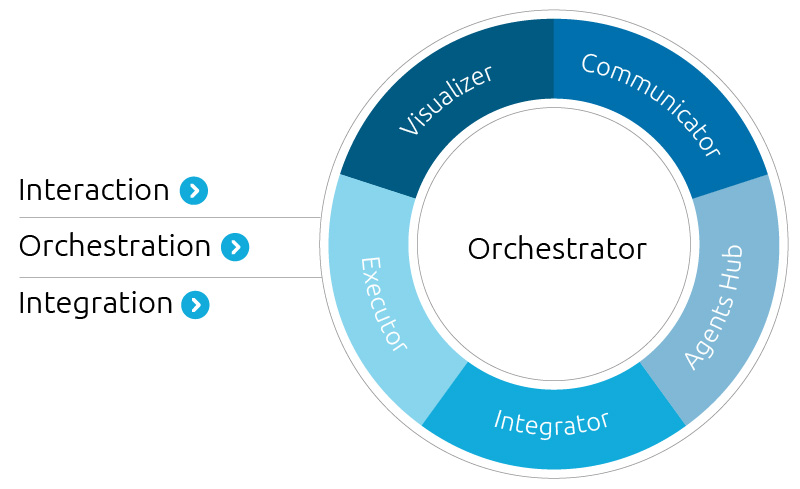Navigating Tomorrow – Forward Focus
In the rapidly evolving landscape of technology, staying ahead requires more than just incremental improvements; it demands revolutionary innovation.

Among the most exciting advancements in this field is the emergence of Multi-Agent Systems (MAS) powered by Generative AI. These systems are not merely about automating tasks; they represent a paradigm shift in how organizations can achieve unprecedented levels of efficiency, scalability, and intelligence.
Multi-Agent Systems, by design, consist of numerous autonomous agents, each capable of performing specialized tasks. When integrated with Generative AI, these agents become even more powerful, capable of reasoning, learning, and adapting in ways that closely mimic human intelligence. This synergy between MAS and Generative AI paves the way for creating dynamic, responsive, and highly effective solutions to complex problems.
What truly excites me about MAS is the concept of Agents. These agents are not just performing tasks; they are advocating for your success. They understand context, make informed decisions, and communicate results in the most effective format, whether it’s text, voice, or images. This multimodal interaction ensures that you get the information you need in the way that suits you best. These agents ensure that they work together as a team to take actions as per your intent and executes team.
The scalability of MAS is a game-changer. As organizations grow and evolve, the ability to scale processes and decision-making capabilities is crucial. MAS’s intelligent Agents can handle increasing complexity and workload, ensuring that productivity and efficiency are maintained even as demands escalate.
Gartner®’s Impact Radar for Generative AI
The Gartner® Emerging Tech Impact Radar: Generative AI report highlights the strategic importance and future potential of technologies like Multi-Agent Systems. According to the report MAS falls within the realm of high-impact innovations expected to shape the future of AI applications.
The Gartner Impact Radar Chart for Generative AI provides a clear visualization of where MAS and other related technologies stand in terms of their expected impact and adoption timeline.
The report categorizes MAS under the “Application-Related” section and emphasizes their transformative role over the next few years. This recognition by Gartner underscores the growing significance of MAS in driving productivity and innovation across industries. It’s evident that MAS, with its promise of intelligent orchestration and seamless integration, is ready to become a cornerstone of next-generation AI solutions.
Let’s understand the business side of such a system and see why organizations will need such an Agent solution which is yet to be realized.
Why organizations need Generative AI powered Multi-Agent Systems
In today’s fast-paced business environment, organizations face a multitude of challenges that require agile, intelligent solutions. Traditional systems and manual processes often fall short in addressing these needs. Here’s why MAS powered by Generative AI is essential for modern organizations:
- Enhanced Decision-Making: MAS leverages AI to analyze vast amounts of data and provide actionable insights. These agents can make informed decisions quickly, which is crucial in dynamic business scenarios.
- Improved Efficiency and Productivity: By leveraging the capabilities of Generative AI to move beyond productivity. The MAS brings a network of Agents which can understand the intent, plan and execute the plan by connecting to various systems. MAS frees up human employees to focus on more strategic activities. This leads to significant improvements in overall productivity and operational efficiency.
- Scalability: As organizations grow, their processes and systems must scale accordingly. MAS provides a scalable solution that can handle increasing workloads and complexity without compromising performance.
- Seamless Integration: MAS can interact with existing systems in a human-like manner, bypassing the need for traditional APIs or predefined methods. The agents can interact with each other in a human like natural language integration. This ensures smooth integration with current infrastructure and minimizes disruptions.
- Adaptive Learning and Flexibility: Generative AI enables MAS to learn and adapt over time. This means that the system can evolve with the organization, continuously improving its performance and capabilities.
- Cost Savings: By automating processes and reducing the need for manual intervention, MAS can lead to significant cost savings. Additionally, the efficiency gains can translate into faster time-to-market for new products and services.
The Pillars of Multi Agent Systems
Interaction: Seamless Multimodal Communication
One of the most striking features of MAS is its ability to understand and respond to natural language inputs. These systems use multimodal inputs and outputs, allowing for seamless communication that mimics human interaction. This means that the advocates interact with each other in a natural language i.e. from each other’s output in textual or image format. This phenomenon is extremely important when it comes to interaction with different systems across technology and versions.
For the user, this also means that whether you’re speaking in any language, typing, or using other input methods, the agents can understand and act upon your commands effectively.
Orchestration: Intelligent Workflow Management

The heart of MAS’s orchestration capability lies in its team of agents with persona-based reasoning. These agents, can make decisions, take actions, generate actionable insights, and predict outcomes.
The Orchestrator Agent, a central component, understands the user’s intent and crafts a comprehensive plan. This plan is then executed by various specialized agents, each performing specific tasks and collaborating to achieve the desired outcome. This orchestration is not just efficient; it’s intelligent, enabling dynamic adjustment and optimization of workflows.
Integration: Human-like system interaction
MAS’s integration capability sets it apart from traditional solutions. These systems can interact with other systems like humans do, bypassing the mandatory need for conventional APIs or predefined methods. This human-like interaction simplifies integration with existing systems and processes, making MAS a versatile and scalable solution for any organization.
Conclusion
In conclusion, Multi-Agent Systems using Generative AI represent a significant leap forward in how we leverage technology to solve complex problems. By integrating intelligent Agents into our workflows, we can achieve a level of efficiency, scalability, and effectiveness that was previously unattainable. These Agents are not just Gen AI based productivity solution, they are partners in your journey towards greater productivity and success.
I am incredibly excited about the future of MAS and the potential it holds for transforming organizational efficiency. Embracing this technology means not just staying ahead of the curve but defining the curve itself. The future of productivity is here, and it is intelligent, dynamic, and scalable.
Contact us to learn more about how Multi-Agent Systems can revolutionize your approach to productivity and efficiency.
Source:
- Gartner Article, Understand and Exploit GenAI With Gartner’s New Impact Radar, By Lori Perri, December 21, 2023. https://www.gartner.com/en/articles/understand-and-exploit-gen-ai-with-gartner-s-new-impact-radar. GARTNER is a registered trademark and service mark of Gartner, Inc. and/or its affiliates in the U.S. and internationally and is used herein with permission. All rights reserved.
- https://emt.gartnerweb.com/ngw/globalassets/en/articles/images/impact-radar-for-generative-ai.png

 English | EN
English | EN 